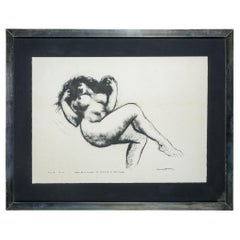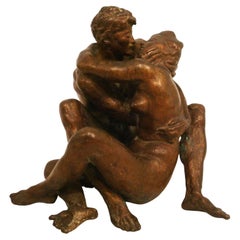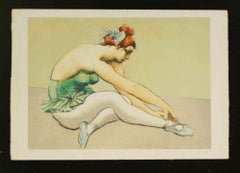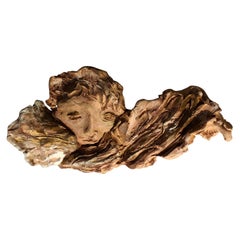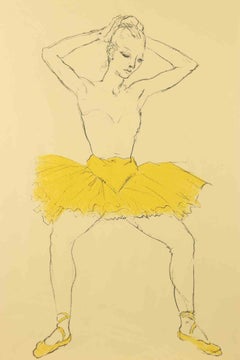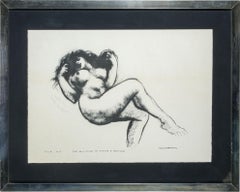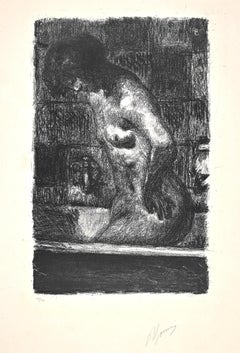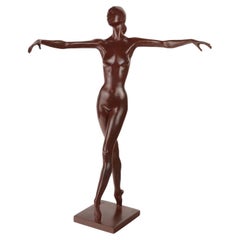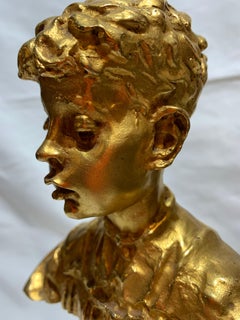Francesco Messina Art
to
1
6
7
6
1
1
1
1
Francesco Messina Italian Signed Modern Work on Paper
By Francesco Messina
Located in Roma, IT
Beautiful lithograph by the great postwar Italian artist Francesco Messina.
Depicts in a beautiful pose a nude of a woman "Lying Model"
Very rare "Artist's Proof Hors Commerce" with ...
Category
Mid-20th Century Italian Mid-Century Modern Francesco Messina Art
Materials
Glass, Wood, Paper
Mid-century Nude Lovers Bronze Sculpture Statue By Francesco Messina
By Francesco Messina
Located in Buenos Aires, Olivos
Fantastic Sculpture of a couple of naked lovers kissing, Both nude.
Perfect size, will go perfect in any space.
Francesco Messina (15 December 1900 – 13 September 1995) was an Italian sculptor of the 20th century.
Francesco Messina was born at Linguaglossa in the Province of Catania in a very poor family. Growing up in Genoa, where he also studied and lived until he was 32, he then moved to Milan.
Art historians consider him one of the most important figurative sculptors of Novecento, together with Giacomo Manzù, Arturo Martini, Marino Marini. He is the author of some of the greatest works of the Novecento Italiano[citation needed] and his sculptures are displayed in the most famous museums, among which: Bern, Zürich, Gothenburg, Oslo, Munich, Paris, Barcelona, Berlin, São Paulo, Buenos Aires, Venice, Moscow, Saint Petersburg, Vienna, Washington, D.C. and Tokyo.
From 1922, he began exhibiting his work regularly at the Biennale Internazionale d'Arte in Venice and between 1926 and 1929 he took part in the expos organised by the art group Novecento Italiano in Milan. In 1932, he moved to Milan, where in 1934 he obtained a tenured professorship 1934 in Sculpture at the Accademia di Belle Arti di Brera, of which he became the director within two years.
During those years, about him wrote Carlo Carrà:
Francesco Messina's sculpture is characterised by a simple and grandiose manner, by an idealistic and classic procedure, able to give life to forms which become "ideal images".
In the 1930s, Messina exhibited at important collective expos of Italian art in Barcelona, Berlin, Bern, Gothenburg, Munich, Oslo, Paris, São Paulo, Zurich, while executing various sculptures in many Italian cities. In 1936 he was appointed director of the Accademia di Brera, which position he will keep until 1944. His work was also part of the sculpture event in the art competition at the 1936 Summer Olympics.[
In 1938, Giorgio de Chirico in Rome and Salvatore Quasimodo in Turin presented two personal exhibitions of Messina's work. In 1942 he won the Sculpture Prize at the XXIII Biennale Internazionale d’arte of Venice, where he exhibited fifteen sculptures and seventeen drawings.
In 1943, Messina was appointed Academic Emeritus of Italy. On the collapse of the fascist regime, he was temporarily dismissed from the academy, only because he had been its director during the fascist period. However, by 1947 he had already regained his professorship. In the same period the artist took part in the Graphic & Sculpture Expo at Buenos Aires, in the Muller Gallery, achieve a noticeable success. In 1949 he exhibited at the 3rd Sculpture International held by the Philadelphia Museum of Art in Philadelphia, together with Marino Marini and Picasso.
Romantica, c. 1973 (Fondazione Cariplo)
In 1956 he participated with a personal exhibition at the XXVIII Biennale di Venezia. In 1963 he produced the great monument to Pope Pius XII for St. Peter's Basilica in the Vatican, as well as the bust of Pietro Mascagni for the Teatro alla Scala. In the same year he was awarded the Michelangelo Prize for Sculpture in Florence.
In 1966 Messina was commissioned by Italian RAI to create the Cavallo morente (Dying Horse...
Category
Mid-20th Century Italian Mid-Century Modern Francesco Messina Art
Materials
Bronze
$2,660 Sale Price
30% Off
Untitled - Etching by Francesco Messina - 1980
By Francesco Messina
Located in Roma, IT
Etching on Magnani-Pescia paper 310 gr/m2, paper size 71cm x 50cm, work size 60cmx43,5cm .
Francesco Messina was born in Linguaglossa in the province of Catania. He is considered by...
Category
1980s Contemporary Francesco Messina Art
Materials
Etching
1950s by Francesco Messina Italian Sculpture Earthenware Angel
By Francesco Messina
Located in Brescia, IT
Rare angel by Francesco Messina
Perfect Condition.
Category
1950s Italian Mid-Century Modern Vintage Francesco Messina Art
Materials
Earthenware
Dancer - Lithograph by Francesco Messina - mid-20th Century
By Francesco Messina
Located in Roma, IT
Dancer is a lithograph realized by Francesco Messina in the mid-20th century.
Hand signed and numbered.
Edition of 125.
Category
Mid-20th Century Contemporary Francesco Messina Art
Materials
Lithograph
1950s Italian Signed Lithograph by Francesco Messina
By Francesco Messina
Located in Roma, IT
Beautiful lithograph by the great postwar Italian artist Francesco Messina.
Depicts in a beautiful pose a nude of a woman "Lying Model"
Very rare "Artist's Proof Hors Commerce" wit...
Category
Mid-20th Century Modern Francesco Messina Art
Materials
Lithograph
Fisherman
By Francesco Messina
Located in Roma, RM
Francesco Messina (Linguaglossa 1900 – Milan 1995), Fisherman (1930)
Bronze sculpture measuring 131 x 52 x 65 cm, signed and dated 1930 on the base.
Francesco Messina’s Fisherman w...
Category
1930s Realist Francesco Messina Art
Materials
Bronze
Related Items
Ads: Life Savers (Blue) By Andy Warhol
By Andy Warhol
Located in Dubai, Dubai
Ads: Life Savers (Blue)
By Andy Warhol
2004
Medium: Offset Lithograph
Paper Size: 34 x 34 inches ( 86 x 86 cm )
Image Size: 26 x 26 inches ( 66 x 66 cm )
Edition Size: Unknown
Category
Early 2000s Contemporary Francesco Messina Art
Materials
Lithograph, Offset
Femme Debout dans sa Baignoire - Lithograph by Pierre Bonnard - 1920s
By Pierre Bonnard
Located in Roma, IT
Very rare edition of only 25 prints on vélin fort, numbered and signed by the artist. Redness on left side of the sheet, otherwise excellent conditions and in full margins.
Dry stamp...
Category
1920s Modern Francesco Messina Art
Materials
Lithograph
$4,683
H 11.74 in W 7.6 in D 0.04 in
Nude Bronze Sculpture
Located in Antwerp, BE
Bronze sculpture of female nude, not signed.
Measures: Height 18 cm.
Width 21 cm.
Depth 22 cm.
Weight 3 kg.
Category
Mid-20th Century Italian Hollywood Regency Francesco Messina Art
Materials
Bronze
Takeshi Kawashima - Titled #3, 1968 Signed Serigraph on Paper 27/100
By Takeshi Kawashima
Located in Keego Harbor, MI
A modern serigraph in colors on paper titled "#3" Takeshi Kawashima. Hand signed in pencil on the lower right. Titled with an annotation of 27/100 on the lower left. Published in 196...
Category
1960s Japanese Modern Vintage Francesco Messina Art
Materials
Paper
$1,200
H 33.5 in W 28.5 in D 1 in
Vintage Italian Alabaster Owl Sculpture Paperweight 1950s-1960s
Located in Clifton Springs, NY
Mid Century Modern sculptural alabaster baby owl features hand carved, abstract shaped body with charming large applique eyes. Soft off-white tones of solid alabaster with beautiful...
Category
Mid-20th Century Italian Mid-Century Modern Francesco Messina Art
Materials
Alabaster
Salvatore Messina, Italian Mid-Century Modern, Abstract Sculpture, Steel, 1970s
Located in Manhasset, NY
Salvatore Messina, Italian Mid-Century Modern, 'Vertical Refraction' Sculpture, Steel, Italy, 1970s
Indoor or outdoor modernist geometric sculpture designed by Salvatore Messina and...
Category
1970s Vintage Francesco Messina Art
Materials
Steel
$5,500
H 63.25 in W 19 in D 16.75 in
Salvatore Messina, Italian Mid-Century Modern, Steel, Abstract Sculpture, 1970s
Located in Manhasset, NY
Salvatore Messina, Italian Mid-Century Modern, Steel, Abstract Sculpture, 1970s
Titled "“Horizontal decomposed refraction,” this work is an abstract folded steel sculpture on a plex...
Category
1970s Italian Mid-Century Modern Vintage Francesco Messina Art
Materials
Steel
$3,500
H 11.25 in W 38.25 in D 13.5 in
Mid Century Lifesize French Bronze Parrots Cockatoos Birds Sculpture Statue
Located in Dayton, OH
Mid 20th century French bronze cockatoos / parrots or birds. This life size art sculpture features a mated pair perched on a tree branch or log with real...
Category
Mid-20th Century Francesco Messina Art
Materials
Bronze
$1,904 Sale Price
45% Off
H 37.5 in W 26 in D 24 in
Endangered Species: Grevy's Zebra By Andy Warhol
By Andy Warhol
Located in Dubai, Dubai
Endangered Species: Grevy's Zebra
By Andy Warhol
1992
Medium: Offset Lithograph
Paper Size: 11.75 x 9.5 inches ( 30 x 24 cm )
Image Size: 8.25 x 8.25 inches ( 21 x 21 cm )
Edi...
Category
1990s Contemporary Francesco Messina Art
Materials
Lithograph, Offset
Ferro & Lazzarini Murano Glass Angel Figurine, Vintage Italy Venice 1950s
By Ferro & Lazzarini 1
Located in Nuernberg, DE
Beautiful Murano hand blown figure made by Ferro and Lazzarini in Italy at the island of Murano. Glass Angel with Gold Fleck Wings and Halo - Red/B...
Category
Mid-20th Century Italian Mid-Century Modern Francesco Messina Art
Materials
Murano Glass
$180
H 4.75 in W 2 in D 2 in
Mid-Century Modern Nude Bronze Sculpture
Located in Vero Beach, FL
Mid-Century Modern Figurative Nude Bronze Sculpture.
This small bronze depicts a surrealistic version of two nude figures in dance movement. It was probably created as a study for a...
Category
Mid-20th Century Unknown Mid-Century Modern Francesco Messina Art
Materials
Belgian Black Marble, Bronze
C F S I, Signed Lithograph, Coney Island, Comic Character Figures
By Marie Roberts
Located in Union City, NJ
C F S I is an original hand drawn lithograph by the New York woman artist Marie Roberts printed using hand lithography techniques on archival Arches paper 100% acid free. C F S I portrays a Coney Island Sideshow Performance with several onlookers standing by the stage watching the show. C F S I is a skillfully expressed comic character figure drawing printed in black ink shaded with colored crayon line textures in shades of red, yellow and blue. C F S I is a very fine impression exemplifying the magic and artistic mastery of hand crafted lithography with its nuanced tusche brush strokes and pencil crayon line textures and shading.
Print size - 29.5 x 21.25 in, unframed, excellent condition, hand signed in pencil by Marie Roberts
Image size - 26.25 x 18.25 in
Year published - 1995
Edition size - 25
Marie Roberts, a Coney Island native is best known for her banners for the Coney Island Circus Sideshow...
Category
1990s Contemporary Francesco Messina Art
Materials
Lithograph
$600 Sale Price
31% Off
H 29.5 in W 21.25 in
Previously Available Items
Bronze Dancer Francesco Messina Posthumous Copy Italy XX-XXI Century
By Francesco Messina
Located in Milano, IT
Bronze sculpture depicting dancer signed Messina at base. Posthumous copy.
Category
21st Century and Contemporary Italian Modern Francesco Messina Art
Materials
Bronze
Altar boy. Francis Messina (1900-1995). Multiple sculpture nr.56/149
By Francesco Messina
Located in Firenze, IT
Cleric. (Altar boy).
Francis Messina (1900-1995).
Multiple sculpture signed and numbered 56/149.
Lost wax bronze gilded with 1000° pure gold. Base in black marble. Gilded bronze N...
Category
20th Century Francesco Messina Art
Materials
Marble, Bronze, Gold Leaf
H 11.82 in W 6.5 in D 3.94 in
Bronze Sculpture by Francesco Messina, Seated Dancer
By Francesco Messina
Located in Milano, IT
Bronze sculpture. Signed and numbered on the reverse, N. 15/75. The theme of dancers, both sculpted and painted or lithographed, characterized, together with the theme of horses, muc...
Category
20th Century Italian Other Francesco Messina Art
Materials
Bronze
20th Bronze Horse Sculpture by Messina
By Francesco Messina
Located in IT
Horse sculpture by Francesco Messina an Italian sculptor.
Francesco Messina (Linguaglossa, 15 dicembre 1900 – Milano, 13 settembre 1995)
The sculpture in object represents a runnin...
Category
Mid-20th Century Italian Francesco Messina Art
Materials
Bronze
Francesco Messina art for sale on 1stDibs.
Find a wide variety of authentic Francesco Messina art available for sale on 1stDibs. You can also browse by medium to find art by Francesco Messina in bronze, metal, gold leaf and more. Not every interior allows for large Francesco Messina art, so small editions measuring 7 inches across are available. Customers who are interested in this artist might also find the work of Ivan Zanoni, Francesco Piranesi, and Bela Bacsi. Francesco Messina art prices can differ depending upon medium, time period and other attributes. On 1stDibs, the price for these items starts at $660 and tops out at $31,067, while the average work can sell for $15,864.
